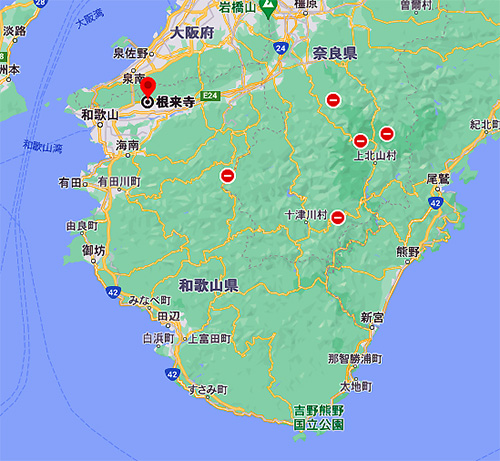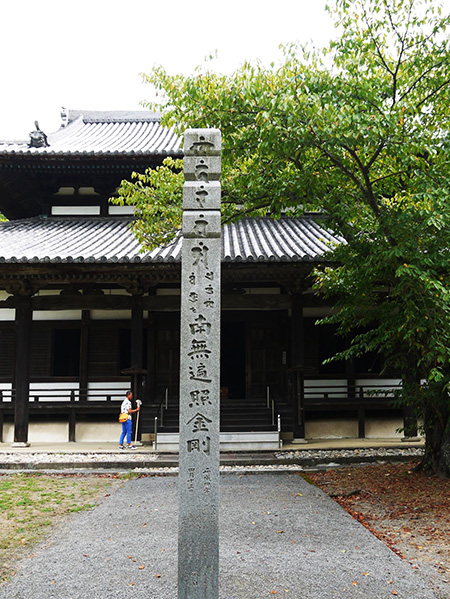

本日は本筋の根来寺建築探訪とは離れて、個人的家系探索篇であります。
わたしの家系には「往昔紀州にて仕官たるところ慶長年中、故ありて浪人と相成る」
という文書を書き残してくれているご先祖さまがいます。
仕官という意味合いからすればどこかの大名家の家臣になっていたようです。
・・・故ありて、とだけ記載して名と地域・主家を明記しないのはなぜなのか?
この記述を残した先祖は1830年頃にこの記述を書いた。
慶長、たぶん関ヶ原が起点になった紀州での政治変動での「浪人」が自然。
書いた時点からさかのぼること200年ちょっとの祖先に関することで、
その「浪人した先祖」の子どもたちの消息は詳細に記述がある。
だけれど浪人本人の名前は記述がないのです。
紀州から毛利圏・広島県の広島空港近辺で、真言宗派の竹林寺に近い地に
一家を挙げて移住している。前職が武家ですぐに庄屋の立場になっているし、
やがて子孫は「苗字帯刀御免」の役儀にも就いている。
どうも主家を離れるとき、そこそこの退職金も得ている気配を感じる。
長男は医師として身を立て地域に地蔵堂を建てられて顕彰されてもいる。
であるのに、主人である浪人は名も書かれずひっそりしている。
想像すれば関ヶ原で西軍派に属して毛利に気脈を通じていたことが、
主家大名家にとって都合が悪く、徳川の世ということで名乗りもはばかったのか。
場合によっては公儀から探索訴追される可能性もあった?
慶長年中とは1596年から1615年までの期間を指し関ヶ原合戦は1600年10月。
戦国末期に至って紀州は中央政権・信長や秀吉の侵攻で宗教支配が制圧される。
そして秀吉の弟・秀長の支配からその死後は豊臣氏直轄支配となり、
いくつかの小大名が存在している。その時期紀州に縁のあるのは、
田辺泊山城→上野山城:杉若氏(1万9千石)〜関ヶ原後改易。
新宮城:堀内氏善(2万7千石)〜関ヶ原後改易。
和歌山城:桑山重晴(2万石)〜関ヶ原後も本領安堵・紀州藩存続。
という三氏が浮かび上がる。桑山家はその後も存続しているけれど
西軍に参加したと思われる杉若氏と堀内氏は改易されている。
これらの県南部の石高の小さな小大名はたぶん「水軍」で海上ネットワークが資産。
普通はそう考えられる。もともとは熊野水軍系か。
・・・どうもこれらは水軍系でちょっと文化的に違うように思われる。
高野山や根来寺という真言宗派の影響を受けた県北地域の方が自然。
そうすると桑山氏の系列が想定できる。
桑山氏は基本は秀吉の弟・秀長の家臣代表みたいな存在だけれど、
秀長は権力中枢で忙しく領国支配は桑山がほぼ全権を握り秀長死後は独立的立場。
事実関ヶ原では東西両軍に両端を持していた痕跡が濃厚なので、
わが家の先祖はその後の経緯を考えれば西軍毛利氏との関係が深かったと思える。
しかも落ち延びて入植の入野に真言宗の古刹(730年創建)竹林寺もある。
敬虔な真言宗徒なれば、この宗門性重視はこの時代人として腑に落ちる。
高野山、根来寺と続いてのこの探究は見えない血に導かれている気もする(笑)。
明日以降、もうちょっと建築に関心を寄せていくので本日はご容赦を。
English version
[Battle of Kishuu, Search for Sekigahara and Roots Visit Negoroji-3]
Today is a personal family exploration, apart from the main Negoroji architectural exploration.
My family says, “Once upon a time, I was a clerk in Kishu, and during the Keicho era, I became a ronin.”
There is an ancestor who left behind the document.
From the meaning of a clerk, it seems that he was a vassal of some daimyo family.
… Why isn’t the name, area, and owner specified just because there is a reason?
The ancestors who left this description wrote this description around 1830.
Keicho, probably the “Ronin” in the political change in Kishu, which started from Sekigahara, is natural.
It’s about 200 years since I wrote it, and it’s about an ancestor.
The whereabouts of the children of the “Ronin ancestors” are described in detail.
However, the name of the Ronin himself is not described.
From Kishu to the Mouri area, near Hiroshima Airport in Hiroshima Prefecture, near Chikurin-ji Temple of the Shingon sect
The whole family is moving. My previous job was a samurai family, and I was immediately in the position of a scholar.
Eventually, the descendants also took on the role of “Last Name Band Sword Exemption”.
When I leave the main house, I feel that I am getting a decent retirement allowance.
The eldest son has been honored by building a Jizo-do in the area as a doctor.
However, the master Ronin is quiet without a name written on it.
Imagine that in Sekigahara, he belonged to the Western Army and had a bloodline to Mori.
It was inconvenient for the main family, and was it foolish to call himself because of the Tokugawa world?
In some cases, was there a possibility of being prosecuted for exploration by public affairs?
The period from 1596 to 1615 is the period during the Keicho period, and the Battle of Sekigahara was in October 1600.
At the end of the Warring States period, Kishu was overwhelmed by the invasion of the central government, Nobunaga and Hideyoshi.
And from the rule of Hideyoshi’s younger brother Hidenaga, after his death, he became under the direct control of Toyotomi.
There are several small daimyo. At that time, Kishu had a connection
Tanabe Tomariyama Castle → Uenoyama Castle: Mr. Sugiwaka (19,000 stones 1585-1600) -Repair after Sekigahara.
Shin Miyagi: Mr. Horiuchi (27,000 stones, 1585 to 1600) -Battle of Sekigahara.
Wakayama Castle: Shigeharu Kuwayama (20,000 stones, 1585 to 1600) -The main territory of relief and the Kishu domain survived after Sekigahara.
Three people emerge. The Kuwayama family has survived since then
Mr. Sugiwaka and Mr. Horiuchi, who are believed to have participated in the Western Army, have been reformed.
The small daimyo of Kokudaka in the southern part of these prefectures are probably “Navy” and the maritime network is an asset.
Usually that is the case. Originally Kumano Navy system?
… It seems that these are navy and a little culturally different.
The northern part of the prefecture, which was influenced by the Shingon sect of Mt. Koya and Negoroji, is more natural.
Then, Mr. Kuwayama’s series can be assumed.
Mr. Kuwayama is basically like Hideyoshi’s younger brother Hidenaga’s vassal representative,
Hidenaga is busy with the center of power, and Kuwayama has almost full control over the territory, and he is in an independent position after Hidenaga’s death.
In fact, in Sekigahara, there are many traces of having both ends in both the East and West forces, so
It seems that the ancestors of my family had a close relationship with Mr. Mouri of the West Army, considering the circumstances after that.
Moreover, there is also an ancient temple of the Shingon sect (built in 730), Chikurin-ji, in the settlement of the settlement.
If you are a devout Shingon Buddhist, this emphasis on sectarianism falls into your mind as a person of this era.
I feel that this quest following Mt. Koya and Negoroji is led by invisible blood (laughs).
From tomorrow onward, I’ll be more interested in architecture, so please forgive me today.
Posted on 11月 16th, 2021 by 三木 奎吾
Filed under: 住宅マーケティング, 日本社会・文化研究, 歴史探訪








コメントを投稿
「※誹謗中傷や、悪意のある書き込み、営利目的などのコメントを防ぐために、投稿された全てのコメントは一時的に保留されますのでご了承ください。」
You must be logged in to post a comment.